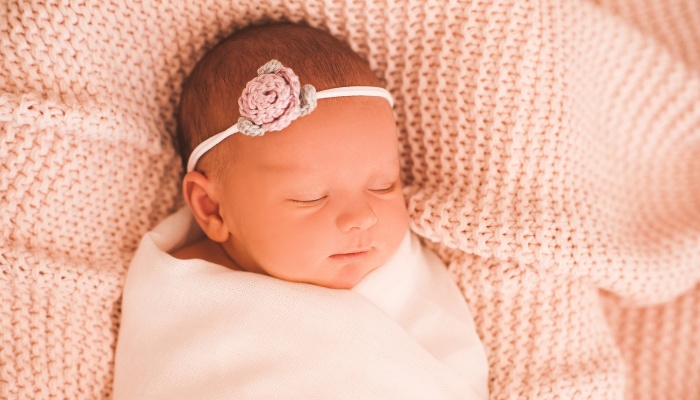Reworded:
Swaddling is a technique used to provide comfort to babies while they are falling asleep by mimicking the feeling of being in the womb. Although swaddling is a widely used method for calming babies, some may not respond positively to it.
Why does my newborn hate the swaddle? A newborn may hate swaddling because they prefer to have freedom of movement or are uncomfortable. Discomfort can occur for a variety of reasons including temperature and how the swaddle fits. Though some babies eventually take to the swaddle, others will continue to fight it.
Keep reading for more information about swaddling, why some kids like it, why others don’t, and how to do so safely.
Newborn Hates Swaddle – 7 Reasons Why
Swaddling definitely comes with a learning curve and may take a few tries to perfect. If your little one is struggling with their swaddle, here’s why it may be happening.
1. Swaddle Is Too Tight
Babies, much like adults, become uncomfortable when they feel too restricted. So, if you’ve swaddled your child too tightly, they may get fussy.
The general rule of thumb is to be able to comfortably fit two fingers between the swaddle and the baby’s skin.
In addition, a swaddle that’s too tight poses health risks to the baby. Consistently swaddling your little one too tightly can cause hip dysplasia, where the hip bone becomes dislocated.
In severe cases, a tight swaddle can also cut off air or circulation.
2. Swaddle Is Too Loose
Any parent swaddling for the first time can tell you how easy it is to swaddle too loosely.
If your child is swaddled too loosely, they may have just enough range to become annoyed as they get caught up in the blanket. Due to this, they fight harder than normal to break free of the swaddle.
As the baby undoes the swaddle, they may cover their face with parts of the blanket. For this reason, swaddling too loosely poses the immediate risk of suffocation and an increased risk of SIDS.
3. Baby Is Too Hot
Babies are more temperature sensitive than adults, and it’s vital to keep your baby cool while they’re sleeping.
If your little one is flushed, sweating, warm to the touch, restless, irritable, fatigued, vomiting, or has an elevated heart rate, then they’re likely too hot.
You want your child in one more layer than what the average adult is comfortable in at any given temperature.
Keep in mind that the swaddle counts as a layer of clothing. If you notice your child overheating often, try to use a thinner swaddle.
4. Swaddled When Not Sleepy or Calm
Swaddling is meant to induce a calm state to urge babies to bed. However, a swaddle can have the opposite effect if the baby is not ready for bed.
Being restricted when they have the energy to continue playing may cause your child to be irritable or throw them into a fit.
5. Baby Prefers Freedom of Movement
Some babies simply don’t like being restrained in any way. If a baby prefers freedom of movement, they’re going to get fussy the moment you try to bind their arms.
One alternative that adds the comforting touch of a swaddle without restriction is a sleep sack.
6. Limbs Positioned Uncomfortably
No one enjoys being stuck in an uncomfortable position, but if your baby’s arms or legs are not secured properly when swaddled, that is exactly what your baby may experience.
Be sure that the arms are in the proper position before swaddling, and check to be sure that both legs are stretched out and not bent uncomfortably.
Keep in mind that for some babies having the arms restrained feels unnatural, and they may never adjust to the sensation.
7. Baby Is Too Old To Be Swaddled
If a baby is too old to be swaddled, you will be able to tell as the swaddle will seem snug in areas that it shouldn’t, such as around the arms, around the neck, and against the chest or stomach.
Babies shouldn’t be swaddled after they can roll over as it increases the risk of SIDS.

When To Swaddle a Baby
While swaddling can be a comfort for babies and a valuable tool for parents, there are stipulations as to how and when it should be used.
For example, a baby can be swaddled from birth to only around 2-4 months of age when rolling attempts are likely.
Generally, parents swaddle their babies right before naps and bedtime, but others also use a swaddle to comfort and settle a fussy baby.
Should I Swaddle My Newborn at Night?
It’s absolutely okay to swaddle your newborn at night. Swaddling mimics the warm and close feeling of your uterus and can help the baby to sleep.
Swaddling should be stopped when your baby shows signs of wanting to roll over.
If you continue to swaddle your baby beyond this point, they could roll over during their sleep. Without freedom of movement in their arms, rolling puts them in a dangerous position with an increased risk of suffocation and SIDS.
How Long To Swaddle Newborn During the Day
There is no defined limit on how long you can swaddle your baby during the daytime. Swaddling parents recommend swaddling for every sleep period, including daytime naps, to encourage better sleep quality.
The American Academy of Pediatrics warns against swaddling too consistently for long periods of time due to the risk of hip dysplasia.
How Long To Swaddle Baby Per Day
There is no limit for how long to swaddle per day. Understanding the risks of repeated long-term swaddling and gauging your child’s reaction will help you make an informed decision.
Is It Ok Not To Swaddle a Newborn?
Yes, it’s okay not to swaddle your newborn. Whether it’s because they don’t like it or it isn’t necessary for them to sleep, sometimes it’s easier not to swaddle.
Whatever works best for your family and provides a safe sleep environment should be done. As with many aspects of parenting, there is no wrong answer when it comes to swaddling your newborn.
Baby Wakes Up Fighting Swaddle
If your baby fights a swaddle while falling asleep, it’s likely that they will wake up frequently because they are uncomfortable. Sometimes a swaddle just takes some getting used to.
However, if they repeatedly wake up fussy, irritable, and struggling against the swaddle, it’s a sign that they may not like being swaddled and would sleep better without it.
Swaddle Alternatives
It can be discouraging when your baby doesn’t wish to be swaddled, but you shouldn’t give up hope. There are tried-and-true methods that may work as a swaddle alternative for your baby:
- Sleep Sacks: Sleep sacks provide freedom of movement in the arms and legs while still warming the child as a swaddle would.
- Nighttime Routines: A routine is a powerful tool for children. Repeated calming nighttime activities such as bathtimes and lullabies signal to children that it’s time for sleep.
- Skin-to-Skin: Stripping a baby down to their diaper and placing them against your bare chest is shown to have calming and stabilizing effects. We talk more about skin-to-skin in this article about skin-to-skin shirts and tops.
Related Questions:
What’s the Difference Between Swaddling Blankets and Receiving Blankets?
There isn’t much of a difference between the two. Receiving blankets are slightly thicker, but they can double as a swaddle when necessary.
Swaddles may have Velcro strips or clasps to hold them together, and many are specifically shaped to make swaddling easy.
Can You Swaddle With Arms Out?
There is a way to swaddle your baby with their arms out. However, this practice is not recommended by pediatricians because the swaddle has a greater chance of becoming loose while the baby sleeps.
Wrapping It Up
Swaddling can be a safe and effective tool to promote healthy sleep in infants.
However, when done incorrectly, for too long, or with a baby who does not want to be swaddled, there are health risks. Swaddling is not necessary for infant health, so if your child does not take to it, then it’s best to continue without.
Charley is a mother of three with a passion for raising good humans. With her children in tow, she studies English and has made a career creating content about motherhood. In her free time, she enjoys traveling within the states to kayak, camp, and hike.

